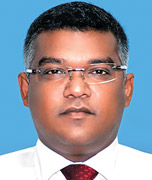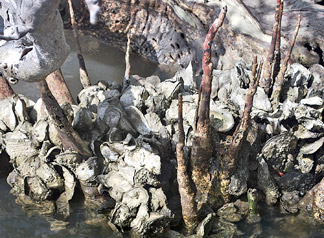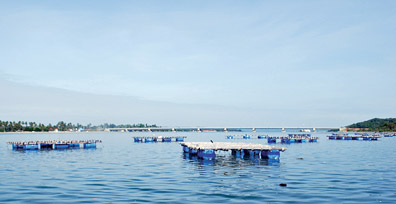|
To create investment opportunities in aquaculture
field:
NARA sets action plan to develop fish industry
By Mohammed NAALIR
|

NARA Chairman
Dr. S. G. Samarasundera
|
Aqua products have become a main commodity in the globe compared to
other products. Shrimp farming and freshwater ornamental fish farming
are practised in Sri Lanka on a commercial level. A few marine aquarium
fish are also being bred in captivity. Other commercial level fin fish
and shell fish aquaculture is in a developing stage. Since there is a
vast natural resource and a suitable environmental condition for
aquaculture, Sri Lanka has a great potential for the development of the
sector and contribute to increase national fish production, National
Aquatic Resources Research and Development Agency (NARA) Chairman Dr.
S.G. Samarasundera said.
He said that sustainable utilisation of the fishery resource is very
important to achieve the production targets. This can be achieved by
promoting the sustainable utilisation of unexploited high demand fin as
well as shell fish species to be popularised in a commercial scale
through fisheries which would lead the way for higher incomes and export
earnings.
Aquaculture and farming contributes significantly to the global fish
and shell fish production. This is a highly developed industry in the
East Asian Region. Mollusk, finfish, shellfish and sea cucumber culture
is at its very initial stages in Sri Lanka.
During the conflict period in the North and the East, the most
significant aquatic sites in those regions were hardly used. Fisheries
and Aquatic Resources Development Minister Dr. Rajitha Senaratne has
instructed NARA to identify the resources and develop a master plan in
developing the industry. With the assistance of consultants from Korea,
Japan and with a local expertise, NARA is producing an action plan in
how to develop this industry as well how to create investment
opportunities in the aquaculture field, Dr. Samarasundera said.
NARA has identified commercially important marine species such as Fin
fish species namely; Sea bass, Grouper and Milk fish (Chanos), shell
fish species such as shrimps (Penaeus monodon, P. indicus) mud crab
(Scylla serrata), Sea crab (Portunus pelagicus), spiny lobsters
(Palinurus spp.) and also species like sea cucumber (Holothuria sp.)
which are naturally available and are high value species for aquaculture
in Sri Lanka. Also locally available sea weed species such as Gracilaria
sp. and exotic sea weed varieties like Kappaphycus alverezii are
commercially important aquatic plant species for farming, according to
Dr. Samarasundera.

oyster attached to the mangrove roots |
 |
| A female crab with eggs |
The world mollusc production was amounted to 13.1 million metric tons
in 2008. Asia contributed to almost 73 percent while only 27 percent
came from the rest of the world, the Chairman said. Mollusc production
contribute 20 percent out of the total aqua production production of
Asia.
The major mollusc producing countries in the ASEAN region are Japan,
Korea and China. Among the species of bivalves cultured and harvested
from the wild in the region are the oysters, cockles and mussels, he
said.
Oysters are very nutritious. It also contains a high level of
glycogen which makes an excellent source of energy that reduces the
workload of the pancreas of the human body.
Complex sugars in the bloodstream must be broken down into glycogen
by enzymes which the pancreas secretes before these are stored in the
liver. Glycogen provided from oysters will reduce the workload of the
pancreas, Dr. Samarasundera said.
Edible bivalve species namely oysters (Crassostrea madrasensis, C.
belcheri, Saccostrea cucullata), mussels (Perna perna, Perna viridis),
clams (Marcia opima, Marcia hiantina, Geloina coaxans, Meretrix
meretrix, M. casta), Cockles (Gafrarium tumidum, Anadara sp.) and other
economically important species such as P. vulgaris, P. maxima are
naturally available in marine and brackish water bodies throughout the
coastal areas of Sri Lanka, he said.
At present bivalve farming is also at its initial stage and since
there is a great potential for development of this industry in Sri Lanka
"Divineguma" program under the patronage of Minister Basil Rajapaksa
have initiated 2 main programs on Oyster and Mussel culture in Mannar
and Tricomalee Districts. At the moment we have identified around 100
low income families and have set up culture sites as a lively hood
development project.
I also would like to promote this to the private sector for
investment as this is a highly profitable industry. There is a very high
demand for Oyster and Mussels worldwide and NARA is willing to give
necessary technical support to any private party who like to d invest in
this industry.
NARA is also starting a market research for the local consumption for
Oyster and Mussel as the booming hotel industry requires large
quantities. We are able to direct the parties interested to the best
sites with the most natural resources. These sites are mainly in the
Northwestern and Northeastern provinces, Dr. Samarasundera said.
Although there are between 20-30 commercially valuable sea cucumber
species, here in the Western Indian Ocean only a few have the potential
to be raised in an aquaculture farms. The most common species for which
hatchery technology exists is the sandfish, Holothuria scabra.
This species is one of the most valuable in the market place and
inhabits shallow, near shore environments in tropical climates.
Presently the minimum value of a dried one kilo of sea cucumber is
about $140. NARA has the technical skills in breeding sand fish and
would want the private sector to take the initiative in developing farms
and be a part on this lucrative industry, Dr. Samarasundera said.
Crabs of the genus Scylla are strongly associated with mangrove areas
throughout the Pacific and Indian oceans and form the basis of
substantial fishery and aquaculture operations. Aquaculture production
currently relies on wild-caught seed for stocking ponds, as larval
rearing at a commercial scale is still difficult.
One of the major problems for effective mud crab management and
aquaculture is the likelihood that there are a number of genetically
distinct species. Research has demonstrated the presence of at least
four distinct species i.e. Scylla serrata, S. olivacea (oceanica), S.
tranquebarica and S. paramamosain.
|

Raft culture of mussels |
Laboratory experiments of the larval stages of each species should
provide valuable information on each species' biological and ecological
requirements, NARA Chairman Dr. Samarasundera said.
There are two basic forms of land-based mud crab aquaculture:
fattening of crabs with a low flesh content, and grow-out of juveniles
to market size. Fattening is a very profitable activity, employing high
densities of crabs and low costs. However, total production is low
because of mortalities due to cannibalism.
Grow-out systems for mud crabs show much more variety and production
can be very high. Grow-out systems are usually pond-based, with or
without mangroves, although inter-tidal pens can also be used. Without
mangroves, lower stocking rates provide the best return. In shallow
mangrove ponds, there are two distinct forms of aquaculture: (i)
intensive, with higher stocking rates and supplemental feeding; and (ii)
extensive, in large mangrove silviculture ponds where the stocking rate
is very low, and no supplemental feeding is involved. Growth rates under
all systems are comparable, with production of commercial-sized crabs
three to four months after stocking with seed crabs.
Further research is required into the habitat preferences of each
species so that production techniques can be modified to suit their
respective requirements. With advances in the hatchery production of mud
crab juveniles for stocking into ponds and enclosures, the future of mud
crab aquaculture looks promising.
There has been an artisanal mud crab fishery in the country for
several decades. With the high demand and export of crab, this sector
generates foreign exchange and constitutes an important means of income
generation for local riparian communities. However, the increase in
coastal populations, the high demand for mud crabs from foreign
countries, the ease of collection of in shallow coastal waters by traps,
gill nets, scoop nets, hand picking and the introduction of fattening
for soft shell ones, have all combined to cause overfishing of this
valuable resource. Despite the importance of mud crabs, information of
their biology and ecology which is crucial for management is scarce from
Sri Lanka.
NARA's services for intended investors, the NARA Chairman said.,
NARA has planned to provide following services and facilities for the
investors interested in aquaculture in Sri Lanka such as training and
technology transfer, management and monitoring support, aquatic health
management and health certification for export suitable areas for
mariculture.
Trincomalee district is located in an area of 2,727 square
kilometres. It poses sheltered bays such as Thabalagam Bay, Kinniya Bay,
Clappenberg Bay and Cod Bay which are suitable areas for sea farming
development.
Mannar has one of the biggest natural resources of Oyster in Sri
Lanka.
This area has a huge potential for most of the discussed species
because the Puttalam District has extensive lagoons and canal systems,
and because of its proximity to Colombo is one of the most suitable
areas for marine aquaculture, Dr Samarasundera added. |

